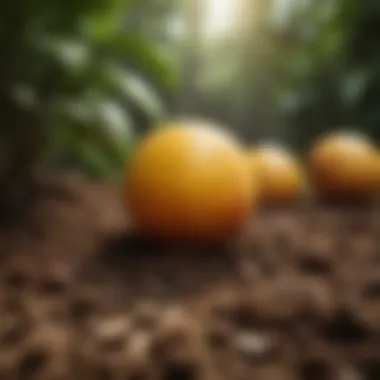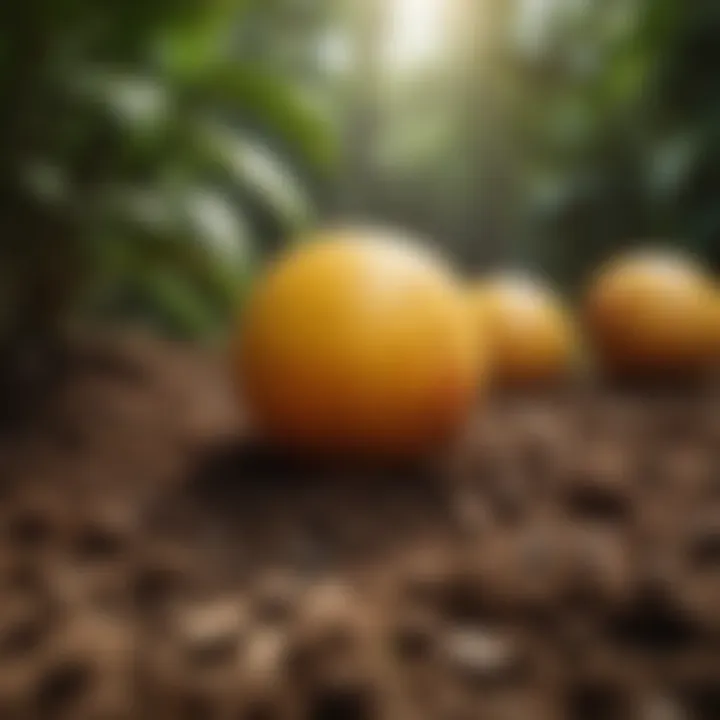Expert Tips for Caring for Mango Trees


Intro
Growing mango trees can be both a rewarding and challenging endeavor. As one of the most beloved fruits in the world, mangoes offer a sweet range of flavors, colors, and textures. The process of nurturing these trees requires more than just planting a seed. It calls for knowledge about their specific needs, from soil preferences to ideal watering practices.
In this guide, you’ll find a wealth of insights designed to help you cultivate healthy mango trees, no matter your level of gardening expertise. From understanding the most suitable growing conditions to managing pests and diseases, each section is crafted to provide you with useful tips and effective strategies. As you embark on this horticultural journey, you'll uncover the intricacies involved in mango tree cultivation, ensuring your efforts yield not only healthy plants but also bountiful fruit harvests.
Understanding Mango Trees
Mango trees originate from South Asia, thriving in warm tropical and subtropical climates. They can grow quite large—up to 100 feet in height—when not pruned. Their wide canopy offers ample shade, and their rich green leaves are highly attractive to the eye.
Mango trees are not just about fruit, but they hold cultural significance, especially in countries like India, where the mango is heavily celebrated. In addition to being a delicious treat, mangoes symbolize wealth and fertility.
"Caring for a mango tree is an investment in flora and future of exquisite flavors."
Key Aspects of Mango Tree Care
Optimal Growing Conditions
Finding the right spot for your mango tree is crucial. Here’s what to consider:
- Sunlight: Mango trees require full sun—at least 6-8 hours daily.
- Temperature: Ideal temperatures range from 70°F to 85°F. They don’t do well in frost.
- Space: Ensure enough room for growth; spacing at least 30 feet apart is often recommended.
Soil Requirements
Mango trees thrive in well-drained soils. Here are some specifics:
- pH Level: They prefer slightly acidic to neutral soil (pH 5.5 - 7.5).
- Organic Matter: Amend soil with compost to improve fertility and drainage.
Irrigation Practices
Water is essential but moderation is key. Consider the following:
- Establishment Phase: Water trees regularly for the first few months.
- Mature Trees: Once established, they can be drought-tolerant. Water deeply but infrequently.
Fertilization Strategies
For healthy growth, focus on:
- Nutrients: Use a balanced fertilizer rich in nitrogen, phosphorous, and potassium.
- Timing: Fertilize in spring and again in mid-summer.
Pest and Disease Management
Mango trees can face threats from diverse pests and diseases. Key considerations include:
- Pests: Watch for aphids, scale, and fruit flies.
- Diseases: Fungal infections like anthracnose can be problematic. Maintain air circulation and consider organic fungicides.
Pruning Techniques
Pruning is necessary for maintaining size and health. Keep these tips in mind:
- Timing: The best time to prune is during the dry season.
- Technique: Remove dead or diseased branches. Shape the canopy to allow light penetration.
Intro to Mango Trees
Mango trees stand as a stalwart symbol of tropical allure, offering not just delectable fruit but also a unique aesthetic to any landscape. Understanding these trees is more than just knowing how to grow them; it entails grasping their place within the environment and culture. Growing mango trees has both practical and emotional benefits. Thoughtfully nurturing these trees can yield bountiful harvests, where each mango offers a taste of the sun drenching the orchards.
Overview of Mango Varieties
Mango trees, scientifically known as Mangifera indica, are not a one-size-fits-all species. They come in an impressive range of varieties, each with distinct flavor profiles, textures, and maturity rates. For instance, the Alphonso variety is cherished for its creamy texture and sweetness, making it a favorite for desserts. Meanwhile, the Haden mango offers a vibrant color and tangy flavor that adds a punch to salsas and shakes.
Exploring these varieties opens the door to personalizing one’s garden or orchard. Familiarizing oneself with these can help enthusiasts plan for both culinary preferences and growth conditions. Here’s a brief overview of some popular mango varieties:
- Tommy Atkins: Known for its bright red and green skin, it’s a favorite in markets due to its long shelf life.
- Kent: This variety has a greenish skin, and is often less fibrous, making it perfect for smoothies.
- Palmer: Recognized for its elongated shape and sweet flavor, this variety also produces fruit late in the season.
Cultural Significance of Mango Trees


Mango trees have been celebrated not just for their fruit but also for their deep-rooted presence in many cultures across the globe. They symbolize love, fertility, and prosperity in various traditions. In India, for example, the mango is often regarded as a sacred fruit, used in religious rituals, marriages, and festivities. The saying "mangoes are the fruit of the gods" is common in those parts, underscoring their esteemed place in society.
Additionally, mango trees provide shade and serve as gathering places communal settings, enhancing their role beyond mere utility. These trees also make for a lovely backdrop in many households, harmonizing nature with the urban environment. The act of planting a mango tree can act as a commitment to future generations, a promise that the lush, juicy harvest will continue to bring joy years down the line.
"In the embrace of a mango tree, one finds not just beauty, but history and connection to the earth itself."
Understanding these elements enriches one’s experience as a mango tree cultivator, emphasizing that caring for these magnificent trees is as much about respect for tradition as it is about agronomy.
Optimal Growing Conditions
Creating the right environment for mango trees is crucial to their growth and fruiting potential. These trees thrive under specific conditions that mimic their native tropical habitats. By focusing on the optimal growing conditions, gardeners can enhance the health of their mango trees and ensure a bountiful harvest. Let's look at the vital aspects of climate requirements and sunlight exposure.
Climate Requirements
Mango trees, scientifically known as Mangifera indica, flourish in warm climates. They prefer temperatures ranging from 77°F to 95°F (25°C to 35°C). Here are some key considerations regarding climate:
- Frost Sensitivity: Mango trees are particularly vulnerable to frost. Even a light frost can damage young leaves and affect fruit development. Therefore, it is advisable to plant them in areas with low frost risk during winter.
- Rainfall and Humidity: While mango trees can handle dry conditions, they do require a well-defined wet and dry season to thrive. An annual rainfall of about 40 to 50 inches is ideal. Humidity also plays a role—excessively humid environments can promote diseases, while too little can stress the tree.
- Temperature Extremes: It’s important to protect young mango trees from extreme heat, especially during their first year. Sometimes, providing shade can help temper high heat.
"The mango tree’s preference for warmth makes it a favorite in tropical and subtropical landscaping, but success lies in careful observation and adaptation to local conditions."
Sunlight Exposure
Sunlight is a non-negotiable factor for healthy mango trees. These tropical beauties need full sun for at least six hours daily. Here are some points to consider regarding sunlight exposure:
- Leaf Development: Sunlight promotes photosynthesis, enabling trees to grow strong foliage. Insufficient sunlight can lead to weak, spindly growth and can make the tree more susceptible to pests and diseases.
- Fruit Quality: Adequate sunlight results in sweeter and better-colored mangoes, making the fruits more appealing. Trees planted in full sun generally yield more fruit compared to those receiving less light.
- Spacing Considerations: When planting mango trees, ensure they have plenty of room. Crowding can block sunlight and increase competition for nutrients, which impairs growth and fruiting potential.
In summary, paying attention to the climate and ensuring ample sunlight will create the right foundation for mango trees to thrive. Proper conditions not only allow for healthier trees but also enhance the quality and quantity of fruit production.
Soil Preparation for Mango Trees
To cultivate mango trees, starting off on the right foot with soil preparation truly makes all the difference. The health of your mango tree hinges on its roots, which, in turn, depend significantly on the soil quality. Proper soil preparation lays the groundwork for robust development and fruitful yields. Think of it like laying a sturdy foundation for a house; without it, everything built atop is sure to crumble eventually.
Ideal Soil pH Levels
Mango trees thrive best in soil that showcases a pH level between 5.5 to 7.5. This range is more than just a number; it creates a conducive environment for nutrients to be absorbed effectively. When the soil is too acidic or overly alkaline, manganese toxicity or iron deficiency can become problematic. Such conditions compromise growth and result in missed opportunities—who wants a stunted tree when nature has given the potential for something magnificent?
Regular soil tests are essential in pinpointing pH levels. If you discover that your soil strays from the ideal range, adjusting pH can be approached either through the addition of lime to raise it or sulfur to lower it. Just as the right seasoning can enhance your favorite dish, correcting soil pH primes your mango tree for successful growth.
"Healthy soil is like the heart of a mango tree, pumping nutrients through roots and ensuring life flourishes above ground."
Enhancing Soil Fertility
Soil fertility isn't just a buzzword; it’s the very lifeblood of successful gardening, particularly for mango trees. Enriching the soil with organic matter plays a crucial role in nurturing your mango tree. Compost, well-rotted manure, or leaf mold—these elements act like a buffet for your tree, offering essential nutrients and enhancing water retention, which is critical in dry spells. It’s worth noting that mango trees prefer slightly sandy loam; too much clay can lead to poor drainage and root rot.
When preparing soil for planting, mix in generous amounts of organic matter. Aim for a nutrient-dense blend that supports not just short-term growth but facilitates long-term health. Consider also incorporating slow-release fertilizers that are rich in potassium for that extra oomph. Time spent now on enhancing soil fertility will pay off down the road in the form of succulent, juicy mangoes.
Remember, a well-prepared soil not only supports growth but creates an ecosystem where beneficial microorganisms can flourish, helping in breaking down organic materials into forms that your mango tree can more easily utilize. A little effort goes a long way in ensuring your mango trees reach their full potential.
Watering Practices
Watering practices are crucial in ensuring that mango trees thrive and produce sweet, juicy fruit. Without the right water management, even the most fertile soil and perfect conditions can leave your tree stressed and undernourished. Proper watering helps in root health, flowering, and fruit setting, so understanding how to cater to a mango tree's specific water needs can make all the difference in your gardening adventure.
Understanding Water Needs
Mango trees, being tropical plants, have particular water requirements that fluctuate with the seasons. During the initial planting phase, your mango tree craves consistent moisture. This means keeping the soil damp, but not soaking wet. Once the tree is established, it becomes more drought-tolerant, though it still benefits from deep watering during the dry months.
Generally, here are some key points to consider:
- First Year: Water every 2 to 3 days in sandy soil and less frequently in clay soil.
- Established Trees: Once the tree is about 1-2 years old, it usually needs water every week.
- Flowering and Fruit Development: Increased moisture is essential during flowering and fruit development stages. This is when the tree is particularly thirsty, so keep a close eye.
One can gauge the need for moisture by checking the top inch of soil. If it feels dry, it’s time to water. However, be wary of overwatering; drowning the roots can cause root rot, leading to disease and ultimately, tree demise.
Effective Irrigation Techniques
Having the right irrigation strategy can save water and improve the health of your mango tree. Here’s how you can optimize your watering efforts:


- Drip Irrigation: This is one of the most effective methods for mango trees. Drip systems deliver water directly to the roots, which minimizes waste and prevents fungal diseases caused by wet foliage. It's like giving your tree a tonic right where it needs it most.
- Soaker Hoses: These can also be useful for young trees. They allow even distribution of water without spraying the foliage, which is helpful for keeping leaves dry.
- Mulching: Adding organic mulch around the base of the tree helps retain soil moisture. Mulch can also deter weeds that compete with the tree for water and nutrients.
- Watering Schedule: Consider the temperature and rainfall when planning your watering schedule. Hot summer days might require more frequent watering while cooler seasons can reduce the needs.
"Proper watering is not just a chore; it's an investment in the health and productivity of your mango tree."
By keeping these watering practices in mind, you ensure your mango tree will not just survive but thrive, yielding fruits that are not only a joy to grow but a delight to eat.
Fertilization Strategies
Fertilization is a cornerstone of mango tree cultivation; it acts as the fuel for growth and productivity. The right nutrients can make all the difference, transforming a barren spot in your yard into a flourishing mango haven. Daily care matters but nourishing the soil is the trick to cultivate healthy foliage and fruit. By understanding the specifics of fertilization, you can ensure that your mango trees thrive and bear luscious fruits year after year.
Types of Fertilizers
Choosing the right type of fertilizer is akin to selecting the proper diet for a growing child. Mango trees benefit from a balanced diet, which includes nitrogen, phosphorus, and potassium, often referred to as N-P-K. Here’s a breakdown of common fertilizer types:
- Organic Fertilizers: Derived from natural sources. Examples include manure, compost, or fish emulsion. They improve soil health over time but act slower than synthetic options.
- Synthetic Fertilizers: Chemically manufactured fertilizers provide nutrients more rapidly. Common brands like Miracle-Gro are popular choices but should be used judiciously to prevent nutrient burn.
- Slow-Release Fertilizers: As the name implies, these gradually deliver nutrients over time. They reduce the risk of over-fertilization and make for easier timing, especially for beginners.
- Liquid Fertilizers: These can be applied directly to the soil or as a foliar spray. They're absorbed quickly, allowing for an immediate boost in growth.
When selecting a fertilizer, don’t overlook the distinct needs of your mango trees. The requirements can vary based on age, growing conditions, and the specific variety.
Timing and Application Methods
Timing is everything, especially when it comes to fertilization. A missed date can mean the difference between misshapen fruit and a bountiful harvest. Here's how to go about it:
- Initial Fertilization: When planting your mango tree, mix a balanced fertilizer into the planting hole. This jumpstarts the growth process and aids root establishment.
- Growing Season: Apply fertilizers during the growing season, specifically in early spring and about every two months throughout the growing season until late summer.
- Post-Harvest: If your tree has yielded fruit, give it a light fertilization afterward. This promotes healthy recovery and prepares it for next season.
- Application Methods:
- Broadcasting: Spread the fertilizer evenly around the base of the tree, accounting for the spread of its roots.
- Soil Injection: For deeper absorption, inject the fertilizer directly into the soil using a garden auger.
- Foliar Feeding: Spray diluted liquid fertilizers on the leaves. This method provides a quick nutrient boost, particularly effective if emergencies arise such as spotting nutrient deficiencies.
"A little bit of care goes a long way in nurturing mango trees; proper fertilization surely pays off beyond your imagination."
Pruning Techniques
Pruning techniques are crucial for maintaining the health and productivity of mango trees. These practices encourage proper growth, improve air circulation, and enhance overall fruit quality. Like sculpting a piece of art, pruning shapes the tree to optimize light exposure and nutrient distribution, ensuring every branch plays a vital role in supporting the fruiting process. Regular pruning helps to keep trees manageable in size, allowing for easier access to the fruit, while simultaneously minimizing the risk of pests and diseases that can thrive in dense foliage.
When and How to Prune
Timing is everything when it comes to pruning mango trees. The best period to prune is just after the harvest, typically in late winter or early spring, before the new growth starts to emerge. This timing helps to promote a burst of healthy growth once the tree wakes from dormancy.
When approaching the task, consider the following techniques:
- Remove dead or diseased wood: Start by cutting away any branches that show signs of damage or disease. This not only makes the tree look neater, but it also prevents potential spread to healthy parts.
- Thin out crowded branches: A mango tree can quickly become overgrown, leading to competition among branches for light and nutrients. Take a look at the structure; remove branches that are crossing or growing inward. This will encourage a more open canopy for better sunlight penetration.
- Shape the tree: Whether you’re going for an open center or a more traditional canopy, be mindful of the overall shape. It’s useful to stand back and assess while pruning to see how it’s shaping up.
Be careful to use clean, sharp tools to make precise cuts. Cuts should be smooth, as jagged edges can invite infection.
Benefits of Proper Pruning
Investing time in proper pruning yields numerous benefits that go a long way in ensuring the vitality of mango trees. Here are some key advantages to consider:
- Increased Airflow: Well-pruned trees allow air to circulate freely, reducing humidity around the foliage, which can help combat fungal diseases.
- Improved Sunlight Penetration: Trees that are trimmed properly can harness sunlight better. It means higher fruit quality and increased yield.
- Disease Management: By removing diseased or damaged branches, the tree becomes less susceptible to pests and infections. This can lead to healthier fruit and less reliance on chemical treatments.
- Enhanced Aesthetics: A well-pruned tree not only looks exquisite but also adds aesthetic appeal to gardens, making them a captivating focal point.
"Proper pruning may feel bittersweet, but it ultimately promotes the sweet fruits of labor."
Pest and Disease Management
In the delicate ecosystem of mango cultivation, pest and disease management stands as a foundational pillar for ensuring the vitality of mango trees. Neglecting pests and diseases can lead to significant losses, not just in yield but also in tree longevity. Throughout the life cycle of a mango tree, various threats may emerge, prompting vigilance from the gardener. Cultivators must recognize these issues in a timely manner to implement corrective measures, preventing extensive damage and enhancing the overall health of the trees.
Common Pest Issues
Mango trees, like many plants, can be susceptible to a variety of pests. Understanding these common pest issues is crucial for effective management. Here’s a look at some of the prevalent pests:
- Mango Weevil (Sternocera.serializer): This pest can wreak havoc by boring holes in the mango fruit which compromise its quality and yield.
- Leafhoppers: These tiny insects suck the sap from the leaves, causing yellowing and stunted growth.
- Aphids: Another sap-sucking pest, aphids can quickly proliferate and weaken the plant, not to mention their role in spreading diseases.
- Scale Insects: These pests are often found on stems and leaves, leading to a sticky residue that can attract further pests like ants.
Regularly inspecting mango leaves and fruit can help spot these pests before they create havoc. Treatments may include horticultural oils or insecticidal soaps that target these pests while minimizing harm to the tree.
Identifying and Treating Diseases
Understanding and identifying diseases is as crucial as managing pests. Diabetes in mango trees may present itself in various ways, often beginning subtly. Signs of trouble range from wilting leaves to uncharacteristic fruit drop. Here are some common diseases that threaten mango trees:


- Powdery Mildew: Recognizable by the white powdery substance on leaves and fruit, this fungal disease reduces photosynthesis, ultimately affecting fruit production and quality.
- Anthracnose: This fungal infection shows up as dark spots on fruits and affects their texture and taste, making them unsellable.
- Bacterial Leaf Spot: This disease produces dark, water-soaked spots on leaves, leading to premature leaf drop and reduced vigor.
Treatment Protocols
- Isolation: First off, isolate affected trees to prevent spreading.
- Hygiene: Ensure tools are sanitized before and after use to avoid transferring pathogens.
- Fungicides/Bactericides: Depending on the disease, apply fungicides or bactericides as needed. Ensure these treatments are applied during cool parts of the day to maximize absorption.
- Water Management: Overhead watering can exacerbate fungal issues; use drip irrigation to keep leaves dry.
- Soil Health: Always aim to maintain robust soil health. Adding organic matter can encourage beneficial microorganisms that fend off diseases.
Proper pest and disease management is key to a healthy mango tree and a fruitful harvest.
In sum, keeping an eye out for pests and diseases cannot be understated in mango tree care. Regular checks, proper treatments, and maintaining overall tree health will yield healthier trees and more delicious fruit.
Harvesting Mangoes
Harvesting mangoes is more than just plucking fruit from a tree. It's a critical stage in the lifecycle of the tree that can significantly impact the quality and flavor of the mango. Knowing when and how to harvest is essential for anyone interested in enjoying homegrown mangoes. Not only does it promise a tasty reward, but it also reflects the care and dedication put into the nurturing of your mango trees.
Identifying Ripeness
When it comes to mangoes, understanding ripeness is an art in itself. Unlike other fruits, mangoes do not have a uniform way of indicating they are ready for harvest. Instead, their signals vary from one cultivar to another. A few key indicators include:
- Color Changes: As mangoes ripen, their skin transitions from green to a more vibrant yellow or red, depending on the variety. For instance, a Haden mango might show an array of reddish hues when ripe, while a Kent mango, on the other hand, can appear more yellowish-green.
- Feel and Firmness: Press gently on the fruit. A ripe mango will yield slightly to pressure, suggesting it is softening on the inside. If it’s too firm, it may require additional time on the tree.
- Aroma: A mature mango will emit a sweet, fruity fragrance, especially near the stem end. This aromatic signal is often the best indicator that the mango is ready to be enjoyed.
"A mango gives its true sweetness only when picked at the right moment."
Proper Harvesting Techniques
Once you've identified that your mangoes are ripe, it’s time to harvest them carefully to ensure the best quality. Here’s how you can go about it:
- Use the Right Tool: Ideally, snip the mangoes off using garden shears or clippers. This helps avoid breaking the stem, which can lead to sap leaking and premature spoilage. A gentle tug might be tempting, but resist it to prevent damage.
- Harvesting at the Right Time: Best to pick mangoes in the early morning or late afternoon. This helps keep the fruit cooler, reducing the chances of bruising and spoilage right after harvest.
- Handle with Care: Place the harvested mangoes into a basket or a padded container. Avoid stacking them too high to minimize bruising.
- Check for Residual Sap: After cutting the mango from the tree, remember to clean off any sap that may have formed on the skin. Not only does this affect the mango’s appearance, but it can also attract pests.
- Storage Considerations: If you’re not consuming the mangoes immediately, place them in a cool, shaded area to continue ripening naturally. Be aware that mangoes can ripen quickly, so check them regularly to ensure they don’t get overripe.
By following these careful selection and harvesting techniques, you'll not only enjoy delicious mangoes but also enhance the overall experience of growing and managing these remarkable trees.
Post-Harvest Care
Caring for mangoes after they’ve been plucked from the tree is a crucial, yet often overlooked, aspect of mango cultivation. Effective post-harvest care can make all the difference between enjoying the sweet, juicy taste of peak-ripened mangoes or biting into a sad, mushy disappointment. This section delves into two primary domains of post-harvest care: storage solutions and how to utilize excess fruit. By understanding these core elements, homeowners and gardening enthusiasts can maximize their mango harvest.
Storage Solutions
Once harvested, mangoes need to be treated with a bit of respect to prolong their flavor and freshness. Proper storage not only extends the shelf-life of the fruits but also maintains their quality during that period. Here are a few tips for effective mango storage:
- Temperature Control: Store mangoes at room temperature for a short period if they are still green. Once they reach an acceptable ripeness, moving them to the fridge can slow down the ripening process.
- Avoid Pressure: Mangoes bruise easily. When stacking them, do so with caution and preferably in a manner that prevents any fruits from resting on top of each other.
- Humidity Consideration: Mangoes thrive in humidity, but too much can encourage mold growth. A breathable storage solution like a basket lined with paper can help maintain just the right environment.
- Ventilation: Ensure good air circulation. A well-ventilated area keeps the fruits aerated and helps avoid spoilage.
By following these steps, mango lovers can extend the time they have to enjoy their delightful harvest, ensuring that the fruits stay juicy and flavorful until they next hit the table.
Utilization of Excess Fruit
Sometimes, the mango tree can be incredibly generous, leaving fruits cascading down like golden treasures. What to do with the surplus? Instead of letting the extra mangoes go to waste, consider these creative uses:
- Mango Chutney: A blend of ripe mangoes, spices like ginger and cumin, along with sugar, creates a tangy condiment that's great alongside curries and sandwiches.
- Smoothies and Juices: Overripe mangoes can easily be transformed into delicious smoothies or juices. Just blend with yogurt or coconut water for a refreshing drink.
- Frozen Treats: Puree mangoes and freeze them in trays for popsicles or add to smoothie blends. This can be a perfect way to cool off on hotter days and still enjoy the sweet flavors of mangoes.
- Baking Ideas: Use excess mangoes in muffins or cakes. They add a moisture-rich texture and a natural sweetness that’s hard to beat.
- Sharing: If all else fails, consider sharing your bounty with neighbors or friends. A cornucopia of mangoes can spread joy, and you’ll be surprised at how a simple gesture can strengthen community ties.
Utilizing excess fruit efficiently ensures that no mango goes uneaten, turning a good harvest into a time of culinary delight and community sharing.
By implementing thoughtful post-harvest care and resourceful usage of surplus fruit, mango tree caretakers can not only enhance their enjoyment of these beautiful trees but also create a culture of sustainability. After all, each mango is not just a fruit but a mini celebration waiting to happen.
Culmination
As we wrap up this comprehensive exploration of mango tree care, it's crucial to reflect on the central themes that have emerged throughout the discussion. When looking after mango trees, one must appreciate that these majestic plants not only offer delicious fruit but also enhance the overall aesthetic of any garden. Whether you are new to gardening or an experienced horticulturist, grasping the core aspects of mango tree care can lead to fruitful outcomes and resilient trees.
Revisiting Key Care Aspects
Returning to the key points, several elements stand out as foundational to successful mango cultivation.
- Optimal Growing Conditions: Ensure that your mango trees bask in sufficient sunlight, as a lack of light can stunt growth and reduce fruit yield. This includes avoiding shaded areas and opting for locations where sunlight is abundant.
- Soil Preparation: Prioritize good drainage and appropriate pH levels in the soil. Using well-drained sandy loam soil tends to be the best bet for mango trees. Fertility can be enhanced through organic matter, providing an ideal environment for growth.
- Watering Practices: Keep a keen eye on watering needs. While these trees are drought-tolerant, they do appreciate regular moisture during the growing season. Over-watering can lead to root rot, which is a sure-fire way to damage your trees.
- Pruning Techniques: Regular pruning helps shape the growth and improves air circulation, ultimately supporting better fruit production. Don’t hold back on trimming away dead branches as this is essential for the health of the tree.
- Pest Management: Stay vigilant for signs of infestations. Quick identification and targeted intervention can save your trees from potential harm, so keeping your garden tools in tip-top shape is as important as caring for the trees themselves.
By consciously implementing these care aspects, homeowners can cultivate mango trees that thrive and bear fruit over the years.
Encouraging Sustainable Practices
Emphasizing sustainability in mango tree care is not just beneficial for your garden; it also plays a significant role in promoting environmental health.
- Organic Fertilization: Use natural fertilizers like compost or well-rotted manure instead of chemical ones. This not only enriches the soil but also minimizes harm to beneficial microorganisms that contribute to soil health.
- Water Conservation: Implementing drip irrigation can conserve water while ensuring your trees receive adequate moisture. This method not only saves water but also reduces fungal diseases by minimizing water splash on leaves.
- Biodiversity: Encouraging a variety of plants around your mango trees can foster a balanced ecosystem. The presence of insectivorous plants can naturally control pest populations, reducing the need for chemical interventions.
- Mulching: Applying an organic mulch around the base of mango trees can retain soil moisture, suppress weeds, and contribute to soil fertility as it breaks down.
By integrating these sustainable practices into your gardening routine, you can create a nurturing environment for your mango trees while also being a responsible steward of the ecosystem. This thoughtful approach not only benefits the trees but contributes positively to the broader environment.







